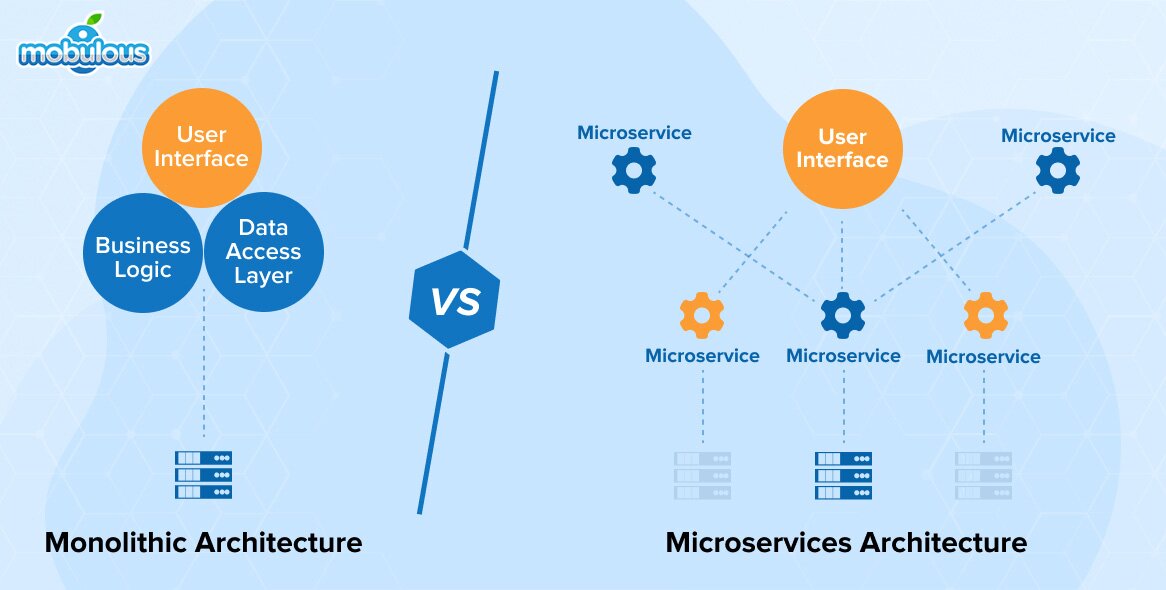
Monolithic vs. Microservices: Which is Best for Build Apps?
When you’re develop an app, how you build it matters a lot. There are two main ways: monolithic and microservices. Let’s talk about both and see which one might be better for your project.
Monolithic: All in One Place
In a monolithic setup, everything about the app is kept together in one big piece. It’s like baking a cake where you mix all the ingredients in one bowl. Here’s what’s good and not-so-good about it:
Pros:
- Easy to Start: develop a monolithic apps is like following one recipe. You don’t have to juggle different tasks or pieces since everything is in one place.
- Testing Made Simple: Since everything is together, testing the app is easy. You can check all parts at once without much trouble.
- Runs Fast: Sometimes, monolithic apps can run faster because they don’t have to talk to other parts far away. It’s like living in a small town where everything is close by.
Cons:
- Can’t Grow Big Easily: If your app gets popular and needs to grow, it’s hard to do with a monolithic setup. You have to change everything at once, which can be tough.
- Stuck with One Style: With a monolithic setup, you’re kind of stuck with one way of doing things. Trying new stuff or adding new features might be tricky.
- One Problem, Big Trouble: If one part of the apps breaks, the whole thing might stop working. It’s like if one light goes out in your house, all the lights go out.
Microservices: Smaller Pieces, More Options
Now, let’s talk about microservices. It’s like building a Lego house, where you have different blocks for different parts. Here’s why some people like it:
Pros:
- Easy to Grow: With microservices, you can add more pieces to your apps without changing everything. It’s like adding more rooms to your house one at a time.
- Use Different Tools: Each piece of the apps can use its own tools and tricks. So, you can try out new stuff without messing up the whole app.
- Not All Eggs in One Basket: If one piece of the app breaks, it doesn’t ruin everything. It’s like if one light goes out, the rest of the house still has light.
Cons:
- More Complicated: Managing lots of different pieces can get tricky. It’s like having lots of moving parts in a machine – you have to keep an eye on everything.
- Talks Take Time: Since all the pieces are separate, they have to talk to each other a lot. This can slow things down, like having to call a friend on the phone instead of just talking face-to-face.
- Hard to Keep in Sync: Sometimes, making sure all the pieces work together can be tough. It’s like trying to make sure all your friends agree on what movie to watch.
Conclusion
So, which one is better? It depends on what you need. If you want something simple and easy to start, go for monolithic. But if you want flexibility and room to grow, microservices might be the way to go. Just remember, each has its own pros and cons, so choose wisely!
FAQ: Monolithic vs. Microservices Architecture
Q: What exactly is a monolithic architecture?
A: Monolithic architecture is a traditional approach where an entire application is developed as a single unit. In simpler terms, it’s like baking a cake where all the ingredients are mixed together in one bowl.
Q: How does microservices architecture differ from monolithic?
A: Microservices architecture breaks down an application into smaller, independent services, each responsible for a specific task or function. It’s like building a Lego house where you have different blocks for different parts.
Q: Which one is easier to start with, monolithic or microservices?
A: Monolithic architecture is usually easier to start with because everything is in one place. It’s like following one recipe for the whole cake. Microservices can be more complex to set up because you have to manage multiple pieces separately.
Q: Can monolithic applications scale easily?
A: Monolithic applications can struggle with scalability because adding new features or handling increased traffic often requires changing the entire application. It’s like trying to make a small car into a big bus – you have to rebuild it from scratch.
Q: Are microservices more scalable than monolithic applications?
A: Yes, microservices are generally more scalable because you can scale individual services independently based on demand. It’s like adding more rooms to your house one at a time instead of building a whole new house.
Q: What are the advantages of monolithic architecture?
A: Monolithic architecture is simple to develop and test since everything is in one place. It can also run faster in some cases because there’s less communication between components.
Q: What are the disadvantages of monolithic architecture?
A: Monolithic architecture can be challenging to scale and update. It’s also harder to adopt new technologies or make changes to specific parts of the application without affecting the whole thing.
Q: How do microservices promote technological diversity?
A: Each microservice in a microservices architecture can be developed using different technologies, allowing teams to choose the best tools for each specific task. It’s like having different tools for cooking different dishes in a kitchen.
Q: What are the challenges of managing microservices?
A: Managing microservices can be complex because you have to deal with multiple moving parts. It’s like trying to keep track of many different tasks at once – you have to stay organized and pay attention to everything.
Q: How do microservices ensure fault isolation?
A: Since microservices are decoupled, failures in one service are less likely to impact the entire system. It’s like if one light goes out in your house, the rest of the lights stay on.
Q: Which architecture is better for small projects?
A: For small projects with limited complexity and scalability needs, monolithic architecture may be more suitable due to its simplicity and ease of development.
Q: Which architecture is better for large-scale projects?
A: For large-scale projects with complex requirements and high scalability needs, microservices architecture is often preferred due to its ability to scale components independently and promote flexibility and innovation.


